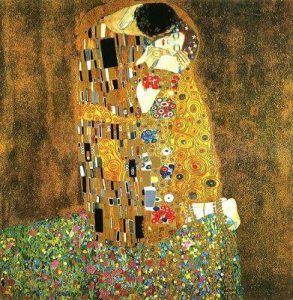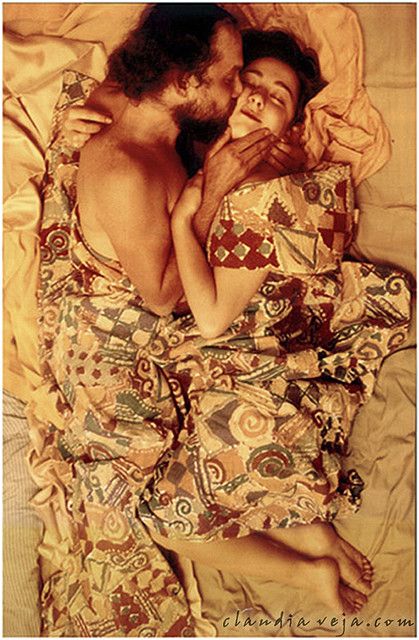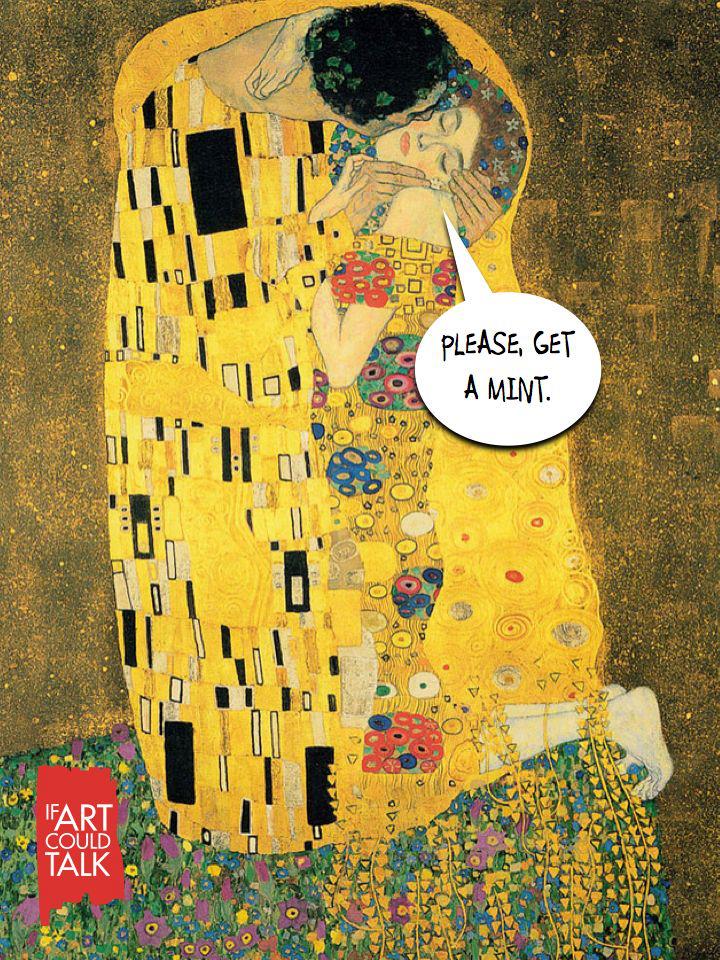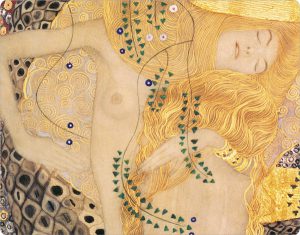Gustav Klimt’s “The Kiss”
by: Ange Han
Gustav Klimt is an Austrian painter and one of the most influential from Vienna. Many of his works have since been critically acclaimed for what they represent as well their aesthetic qualities. I will be delving into his personal background, from his upbringing to his artistic career, then referring back to “The Kiss” and how several of his personal and outside influences helped make it to what it is today – an original masterpiece. Along the way, I will be critically analyzing what the work portrays by focusing on the man and woman’s emotions, and whether or not the female actually desires this intimacy. There has been much controversy over how the male and female interact and this sense of give-and-take love as well as whether or not the encounter fully captures its essence. I believe that the woman senses the intense love from the man and is succumbing to it; however, Klimt seems to paint her not as a symbol of obedience, but rather from adoration. The female is not simply the receiver of the male’s kiss, but the spotlight of the painting itself. Ultimately, I will be considering Klimt’s other works in relation to “The Kiss” while discovering how and why he chose to paint the emotion of love the way he did, with the female at the centerpiece and everything else as details to illuminate her light. (See “The Kiss” (1907-08) below)
Introduction
Perhaps Klimt’s most famous painting is “The Kiss.” It is a work he created during his ‘Golden Years’ when he incorporated utilizing gold in many of his paintings, inspired by Byzantine imagery, and fused this detail with drawings of females. The gold imagery can be repeatedly seen in his later works as well. “The Kiss” captures a man and a woman in a full embrace, as the man tenderly kisses the female on the cheek, and they are draped in a golden aura as well as the deeper golden background. He uses shapes for symbolism, rectangles for masculinity and ovals for femininity. In several of his works, females are at the center and this exploits his fascination and admiration for them, despite never having been married and yet fathering fourteen children⁵. This focus is an important trait of his and reappears in several of his works. Klimt is fascinated by the female body, female expression, and female emotion. If you take a look at his lifetime works, he paints focusing on women more than anything else; men, nature, and symbols simply play background detail. This unique pattern ends up becoming Klimt’s signature style of painting.
Personal Life
Klimt’s childhood provides a deeper insight to the reasoning of his future painting career. He was born on July 14, 1862 until his death on February 6, 1918⁵. He was the second of seven children within a poor family and faced many troubles early on his life with the death of a sister, mental breakdown of another sister, and financial hardships⁵. However, he ended up attending the Viennese School of Arts and Crafts and began his formal career at a time known as the Ringstrasse Era in Vienna¹. During this period, the city was undergoing exponential change in industry, science, and soon to be in the arts. As he progressed in painting, he began to receive some backlash and controversy over the nudity in his works. In his three-part series for the University of Vienna Ceiling Paintings, his interpretations for Philosophy, Medicine, and Jurisprudence was commonly claimed as ‘pornographic’ and ‘perverted excess’ which would end up only hurting his reputation⁵. A Vienna journalist named Karl Kraus proclaims,
“Within days of the exhibition opening, eighty-seven members of the University … had publicly protested about Klimt’s picture and petitioned the Ministry of Education to cancel the commission. They accused Klimt of presenting ‘unclear ideas through unclear forms’ : instead of making an unambiguous statement about the virtues of philosophy he had produced a puzzle which seemed to suggest that the mysteries of life were ultimately impenetrable and that human existence consisted of nothing more than the infinitely repeated cycle of birth, copulation and death.”⁵
Klimt was experimenting with self-expression by painting humans at their most vulnerable, naked, and yet incorporating elements of warm emotions to soothe the foreign looks of bare bodies. He later helped father the Vienna Secession in 1897 which aided him in branching out towards new European styles of painting, especially known for erotic art, and grew to develop his own unique style of painting. The Secession was a breakaway from the usual conservative art in Vienna and introduced modern culture to the city, something that had never been exposed before.
This would only be the beginning of his great exploration with nudity in his works. His modest childhood ended up granting him the willpower to freely express an array of emotions in his own personal style. For Klimt, painting begins and ends as a vessel for getting his voice heard in the world without the restrictions of words nor the inaccessibility of money.
“Whoever wants to know something about me – as an artist which alone is significant – they should look attentively at my pictures and there seek to recognise what I am and what I want.”
“The Kiss”
“The Kiss”, originally called “Der Kuss”, is possibly the epitome of love – as it brings a fuzzy, unquestionable feeling to any onlooker immediately. This artwork was first displayed in 1908 and widely considered as the most famous Klimt work today. When released it defeated previous records for sales, as the Belvedere bought it for 25,000 crowns ($240,000 today) when at the time the highest work bought in Austria reached only to 500 crowns⁴. The work itself is unique in many ways – it’s large, perfect square shape, various notes of gold, fusion of bodies, and multiple patterns. However, the main focus for this abstract painting and the only clear point is in the faces. Steven Zucker states in his analysis of the painting-
“The female figure is completely full frontal but horizontal. So that there’s this beautiful sense of her passivity receiving that kiss, but also a kind of deep interior feeling with her eyes closed. Her fingers just delicately touching his as he holds her head and his neck reaches out and round, and you get a sense of his physical power through the strength of that neck, but also the intensity of his desire.”²
Zucker points out his view of the painting regarding the women’s perspective. The woman is the one getting caressed and loved on in this picture, almost succumbing to the love the man is giving, and the entire embrace seems to melt the two together – strengthened by the orgasmic feel of the kiss. In response to the analytical video by Harris and Zucker, a user comments her contradicting thoughts about the women’s perspective.
One can view the embrace in a different light, like the user above, as one that is unwanted and reluctant. Some view the painting as the woman wants to pull away from the kiss, and that her hands as well as indifferent facial expression supports this notion. The hand that is lightly placed upon the man’s own hand is not grasping it with affection, but rather just placed on top. Her hand on the arm wrapped around his neck shows her fingers intertwined and seemingly nervous and intertwined. Her upper body is posed inwards and seems uncomfortable, but is held in place by the man’s two hands. Although the painting does not suggest any struggle, this point of view is certainly still interesting to consider.
If the painting is viewed in this light, then it takes the meaning of love in a completely different way. Love is portrayed throughout this piece, undoubtedly, but the interpretation can take on several different forms. Love can be a display of mutual agreement, but also a display solely from one side. The man could be pouring his affection on the woman, who may not want it. He could be forcing it upon her. She could be confused on how she is feeling but still accepts his embrace. Perceiving artwork is based on the individual, and although there is no known fact about the thought processes and specific motives Klimt had when painting this picture, it is standard to say that it is love nonetheless. In my view, there is a sense of role reversal because the dominant male is the one displaying his emotion onto the accepting female. Females tend to be stereotyped as being more emotional, but in this case it is the male that is pouring the love. Considering Klimt’s background, he does not seem to devalue women; nonetheless, purposefully create a picture where there lies spite and neglect. Instead, he seems to celebrate the bond between the two. It could even be seen as a representation of Klimt himself and a lover. The perceptions are endless, but ultimately taking into account his other paintings and personal character, Klimt creates “The Kiss” to represent a pure action that accurately sums up the feeling of love that arises during an embrace between lovers.
Gustav notes every little detail in order to capture the essence of romance. He utilizes gold leaf paint in this romantic scene, as well as several other paintings, and the blending of these two tools creates an ultimate dreamy picture. The intertwining bodies of the lovers amidst the complex background creates a stunning portrait that even people like myself, who may have no background knowledge on the work, can’t help but stop to admire. Many onlookers that see it in real life explain that it surpasses all expectations, with its grand-scale as well as intricate coloring and details. Some have even claimed that it is a more influential work than the Mona Lisa, both in scale and ability to stir emotion.“Klimt inhabited an odd, archaic culture where old and new fused in quite different ways from anywhere else.”³ Not only does Klimt address and perfect the aesthetics of an appealing picture, but also intertwines intricate history and minute details that adds an extra depth to the grand scheme.
Examples of “The Kiss”
“The Kiss” has achieved great and wide-spread popularity in the modern world. In fact, it has been reproduced in multiple different mediums. It is becoming a world-wide phenomenon and achieving fame and status that could make it an icon – a work needless of explanation.
(Real life depiction below)
(Comic humor below)
(Tattoo below)
(Wall Art below)
I’ve also seen instances of the painting being reproduced as a phone case, magnet, poster, journal cover, and pillow case.
All of these remakes of Klimt’s “The Kiss” only fuels the popularity of the artwork and what it resonates for the viewer. Jones praises this piece by stating, “This modern masterpiece is self-contained. Perhaps that’s why it doesn’t make us ask any questions, doesn’t make us feel we need further information”³. Klimt fuses abstract painting and historical detail, from the objects to the color tones, with a moment that everyone from a child to an elder can stop and admire because it produces a feeling inside of them that they can relate to. The feeling that is similar to the moment when your mother picks you up and hugs you, when you first receive that awkward hug from the cute boy grade school, when your brother bear hugs you for doing good on your quiz, when your grandma gives you a frail embrace during graduation, when your dog runs towards you and knocks you over after not seeing you all day, and when your spouse pulls you in and kisses you on your head because they just felt overwhelmed with your beauty and character. “The Kiss” does more than showcase a man and woman’s intimate relationship, but it captures the bare essence of love and all of its warm radiation then delivers that straight to the onlooker.
Other Works
“Nudas Veritas” (1899)
This painting is entitled “Nuda Veritas” and when originally released, caused a great debate. Klimt quotes Schiller above the picture of the naked, red-haired woman. The quote says,
“If you cannot please everyone with your deeds and your art, please a few. To please many is bad.”⁵
Klimt approached his life in an incredibly carefree and individual manner, and it shows through his works. He did not work to ‘please’ as he states, but instead pursued art because it was what worked for him. Referring back to the user’s argument that he might have portrayed the female in “The Kiss” as restraining and posing the male as a threat seems to be an approach that does not take his background into account. Klimt did not look down on women, but rather wanted to shine their characteristics and emphasis that beauty. In his great variety of works, all of the females are displayed in a glowing light, soft and mellow, and as ethereal creatures.
“Water Serpants I” (1904-07)
Although throughout his life Klimt never married, he did have a number of companions. Most notably there was Emilie Flöge, the sister of his brother’s widow⁵. However, much of his love life is still unknown. He is to have fathered 14 illegitimate children and been in romantic relationships with several other women. Despite his cloudy love life, through the little facts we do know and especially from his artwork, we can note that Klimt appreciated females to a high degree. He paints them vividly and full of emotion, whether it be in the complexity of structural designs, dreamy looks on their faces, warm color tones, or body language; there is a sense of appreciation and beauty that resonates within the picture and delivers to the viewer.
Conclusion
“The Kiss” portrays two lovers embracing and importantly notes that it is not a mutual kiss, but from one to another. Anyone who sees this painting, which is increasingly becoming more and more recognized, agrees that its gold accents and creative symbols make it hard to look away from. It is feminine in its tone but historical in its method of representation. Then, if you dig deeper into Klimt’s background and history of the painting itself, you are able to understand the many layers that the painting holds – freedom and admiration. There is appreciation for the female in the way the man is holding her, caressing her, and desperately wanting to have all of her. Klimt has painted females in numerous other paintings, but this is the only one where man and woman are together and the interaction is shown. It is not about permission or denouncement; instead, it represents two souls coming as one and the insatiable desire one can have for their lover, a thirst that Klimt and many of his audience can ponder on and relate to.
Bibliography
- “Gustav Klimt Biography, Art, and Analysis of Works.” The Art Story. N.p., n.d. Web. 06 July 2016.
- Harris, Beth, and Zucker, Steven. “Gustav Klimt, The Kiss.” Khan Academy. N.p., 21 June 2012. Web. 06 July 2016.
- Jones, Jonathan. “The Last Romantic.” The Guardian. Guardian News and Media, 22 Sept. 2001. Web. 06 July 2016.
- “The Kiss Gustav Klimt.” The Kiss Gustav Klimt. Art.com, n.d. Web. 06 July 2016.
- Moffat, Charles. “Gustav Klimt – Symbolist Painter – The Art History Archive.” Gustav Klimt – Symbolist Painter – The Art History Archive. N.p., 2009. Web. 06 July 2016.

 ²
²




